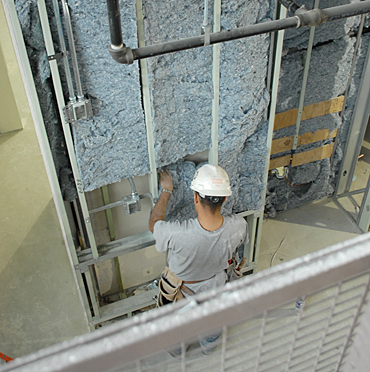ISU leading the way in sustainability in College of Design building addition
04-20-09

A construction worker installs recycled blue jean insulation in the King Pavilion addition to the College of Design. Photo by Heather Sauer, The College of Design
Contacts:
Mark Engelbrecht, Dean of College of Design, (515) 294-7427, mengelbr@iastate.edu
Kerry Dixon-Fox, project manager, (515) 294-8028, kdixon@iastate.edu
Teddi Barron, News Service, (515) 294-4778, tbarron@iastate.edu
Anne Kassel, News Service, (515) 294-6881, akassel@iastate.edu
ISU leading the way in sustainability in College of Design building addition
AMES, Iowa -- Iowa State University is making a significant commitment to sustainability through the design and development of the new building addition to the College of Design. Anticipated to open for classes in August, the King Pavilion will be ISU's first new "green" structure on campus and home to several energy-saving techniques.
The 23,735 gross-square-foot addition was designed under the U.S. Green Building Council LEED (Leadership in Energy and Environmental Design) 2.2 project guidelines. As part of the LEED requirements, the building addition will meet the highest green building and performance measurements, including lower operating costs, increased asset value, reduced waste sent to landfills, decreased water and energy use and reduced greenhouse gas emissions.
"The building is a highly sustainable work of architecture," said Mark Engelbrecht, College of Design dean. "The College of Design has always dealt with the issues of sustainability and is proud that the building is going to be one of the highest LEED rated projects in the country."
Among the building's energy-saving features will be a "living" roof, recycled building materials, day-lighting and natural ventilation.
"Building a LEED project is a very integrated process," said Kerry Dixon-Fox, a university architect and King Pavilion project manager. "We had to work directly with the architect and figure out how all these green projects could integrate with each other."
The "living" roof consists of 12 varieties of low-growing, quick-absorbing and drought-tolerant plant sedums. The sedum roof can absorb and hold 80 percent of the water fallen on it enabling the roof to evaporate the water back into the atmosphere, which reduces the stress and amount of water moving into storm sewers. The green roof also helps reject heat and insulate the building, making it cooler in the summer and warmer in the winter.
There are enough windows in the building to provide plenty of daylight to help reduce electricity. With windows on the bottom and top levels, the building has the ability to pull air from the lower levels out the top, which naturally cools and dehumidifies the air. Because of this ability, the new addition is not air-conditioned.
"With the building's ability to substantially cool itself and because the addition will not be used during the warmest months of the year, we decided not to air condition it," said Dixon-Fox.
As part of the LEED requirements, the building materials used must be partially recycled materials from no farther than a 500-mile radius around Ames. The project uses 75 percent recycled steel, rock bedding from Missouri and recycled blue jean insulation. The building is the first on campus to insulate with the 100 percent cotton product. Similar to the looks of dryer lint, the blue jean insulation is treated to be less flammable, is bacterial and fungal resistant, and holds no chemical odors.
The space includes studios, critique spaces, lecture areas and a specially ventilated spray room. It will be home primarily to students in the college's Core Design Program and students in the architecture, interior design and landscape architecture professional programs.
Upon completion, the building will not only bring all design students under the same roof, it will also provide students with a learning laboratory of sustainable practices and design.
"The building of this addition will show campus that we can do new things," said Dixon-Fox. "We have to learn to conserve the resources we have. And if we use money to make the building as cost-effective and sustainable as possible, then we can use more money toward education -- which is what we're here to do."
-30-